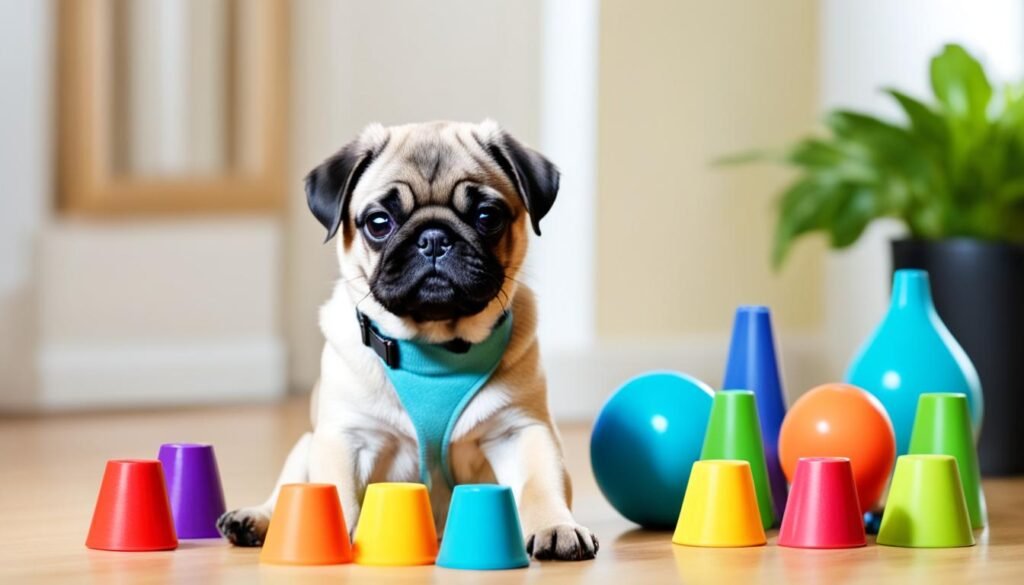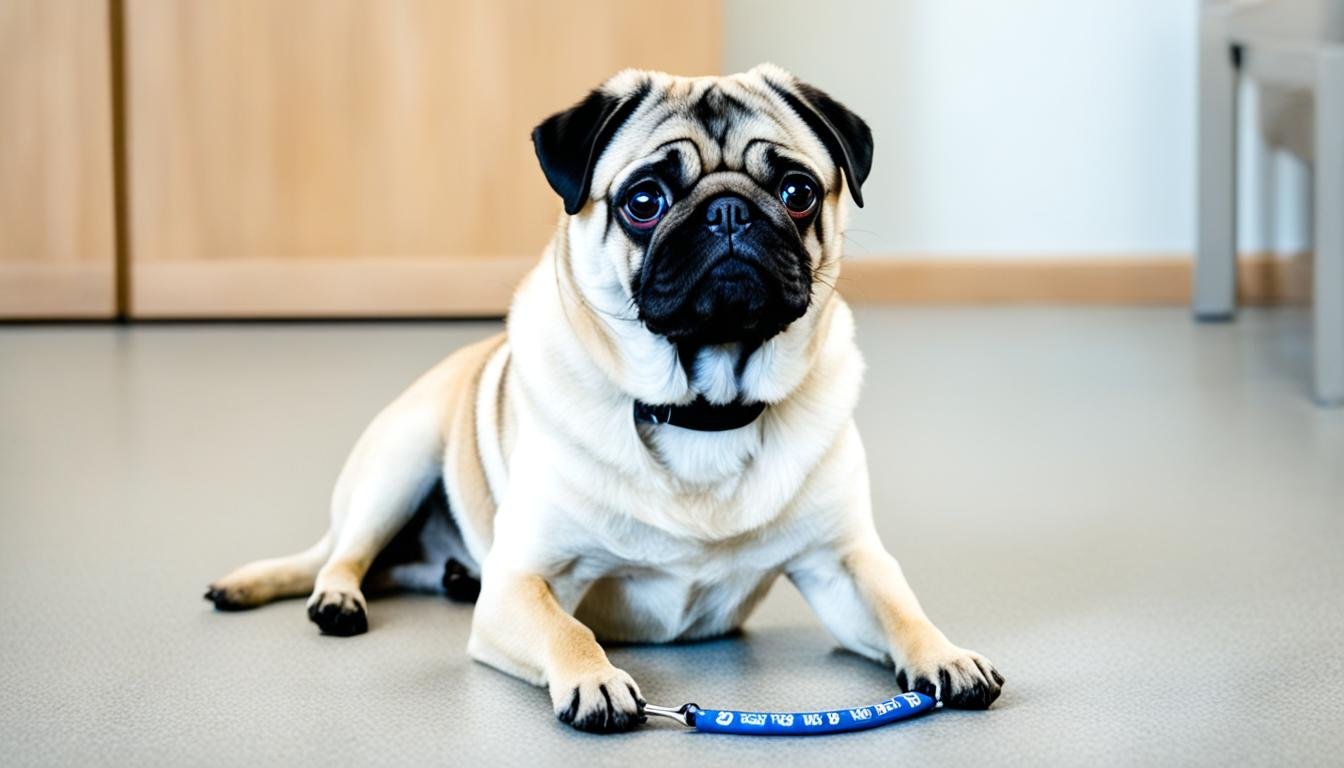The best and worst training techniques for Pugs
Pugs are known for their loving nature, but training them can be tough. If you’re a proud Pug owner, you know how important good training is. This article will cover the best and worst ways to train Pugs. It will help you train your Pug with confidence.
Starting early is key in training Pugs. These little dogs learn fast when they’re young. Early training sets the stage for a well-behaved Pug.
Having a training schedule is also crucial. Consistency is important when teaching your Pug commands. A routine helps your Pug learn faster and strengthens your bond.
Socializing your Pug is very important. Pugs need to meet different people and animals to grow and feel confident. This helps them be well-adjusted and less likely to have behavior problems later.
Taking your Pug to a puppy class is great for socializing and learning obedience. These classes let Pug puppies meet other dogs and learn commands with a professional trainer.
When training, be firm but fair. Use treats to reward good behavior. Pugs love praise and affection, so give them lots when they do well.
Potty training can be hard, but it can get easier. Use positive reinforcement and patience to housebreak your Pug. Consistently reward good potty habits in a specific area.
Trick training is a fun way to keep your Pug’s mind sharp. Pugs are smart and like to learn. Teaching them tricks helps their mind and strengthens your bond.
Remember, training Pugs needs patience, consistency, and rewards. With the right methods and love, you can make your Pug a happy, well-behaved family member.
Starting Early

Starting early is crucial for training Pugs. Begin training when you bring your Pug home. This sets the stage for good behavior and stops bad habits. Puppies soak up information like sponges. Use this time to make training easier and more effective.
Start with basic commands like sit, stay, and come. These commands help set rules and teach what’s expected. Use treats and praise to reward your Pug when they do well.
Don’t think starting early only works for young dogs. Older Pugs can also learn new things with patience and positive reinforcement. It might take longer, but it’s worth it to see them change for the better.
Training your Pug early makes them a better companion. So, don’t wait. Begin training early and enjoy a well-behaved Pug.
Creating a Training Schedule
Having a well-planned training schedule is key to training your Pug well. A routine helps your Pug learn good behaviors and manners. It lets you focus on different training areas like house training, socializing, and grooming.
Start by setting aside time each week for training. Use short, focused sessions since Pugs have a short attention span. It’s better to have many short sessions than one long one.
Include obedience commands like sit, stay, and come in your schedule. These commands are important for your Pug’s training. Practice them often to help your Pug understand and follow them.
Don’t forget to include house training in your schedule. Being consistent is key when training your Pug. Take them out often, especially after meals and play. Use treats and praise when they go potty in the right spot.
Socializing your Pug is also important. Plan outings and playdates with other dogs. This helps them get used to different people and animals.
Grooming is part of your Pug’s routine too. Start grooming activities like brushing and nail trimming slowly and positively. Add these to your schedule to help your Pug get used to them early.
Be consistent and patient with your Pug during training. Pugs like positive reinforcement, so use treats and praise for good behavior. Don’t use punishment or harsh methods, as they can make your Pug scared or aggressive.
Adding a training schedule to your Pug’s routine gives them structure and consistency. This makes them well-behaved and obedient companions.
Socialization

Proper socialization is key for your Pug’s behavior. Pugs are friendly but need to meet different people and see new places. This helps them grow into confident pets.
Take your Pug to busy streets, parks, and other places. This helps them get used to new sights, smells, and sounds. They should meet all kinds of people, like kids and adults, to feel safe in different places.
When you socialize your Pug, make it positive and controlled. Start with small steps to help them feel secure. Encourage them to be friendly with other dogs and animals.
Keep socializing your Pug as they get older. It’s important to keep introducing them to new things. This keeps their good behavior going and stops bad habits.
Taking a Puppy Class

If you’re a Pug owner, think about putting your pup in a puppy class. These classes are great for training and socializing you and your dog. They teach basic obedience skills using positive reinforcement.
Puppy classes have a structured setup. Trainers help you learn how to talk to your Pug and build trust. This way, you and your Pug can connect better.
Positive reinforcement is a big part of puppy classes. It uses treats and praise to make good behavior stick. This makes learning fun for you and your puppy.
Another great thing about puppy classes is socializing your dog. They get to meet and play with other puppies. This helps them learn important social skills.
When picking a puppy class, choose a reputable trainer and a program that fits your goals. Make sure it’s right for your Pug’s age and personality.
Going to a puppy class is good for your Pug’s training and your bond with them. So, take part in these positive classes and see your Pug grow!
Being Firm but Fair
Training a Pug needs a balance between being firm and fair. Pugs can be stubborn, but harsh punishments don’t work well. Reward-based training is better because it motivates them to listen and obey.
Being firm means setting clear rules and expectations. It’s important to be consistent with training. Use a firm voice and confident body language to show what you expect. Pugs like a strong leader.
But, being fair is just as crucial. Don’t punish your Pug too much or use force. This can make training harder and hurt your bond. Stick with positive reinforcement instead.
Reward-based training is about praising and rewarding good behavior. Use treats, kind words, or fun activities as rewards. This makes your Pug want to behave well because it feels good.
Training a Pug takes patience. Every dog learns at their own speed. Be ready to spend time and effort on their training. Keep training consistent, positive, and always be firm but fair.
Potty Training
Potty training can be tough for housebreaking Pugs. But, with the right methods and consistency, you can teach them good bathroom habits. Pugs are smart and want to please, making them easy to train for potty training.
Supervision is key in potty training. Keep a close watch on your Pug, especially at the start. This way, you can stop accidents before they happen and guide your Pug to the right spot.
When your Pug shows they need to go, like sniffing or circling, stop them. Lead them to their bathroom area. This teaches them that spot is where they should go.
Consistency is vital in housebreaking. Make a regular schedule for taking your Pug out to go potty. This includes after meals, naps, and play. A routine helps your Pug learn to go potty at these times.
Positive reinforcement is important in training. Praise your Pug when they go potty in the right spot. Give them a small treat or their favorite toy as a reward. This shows them it’s a good thing to do.
Potty training takes time and patience. It might take up to 6 months for a Pug to learn. Be patient with your furry friend and keep up with consistent training.
Trick Training
Trick training is a great way to keep your Pug’s mind sharp and strengthen your bond. Start with simple tricks like Shake Hands, Dance, and Fetch. Use positive rewards to encourage good behavior.
Once your Pug knows basic tricks, you can try harder ones. You can also mix in obedience skills. Remember, being consistent and patient is important. Set aside time each day for training and be patient with your Pug.
Trick training also keeps your Pug active, which is good for their health. So, be creative, have fun, and enjoy teaching your Pug new tricks!

